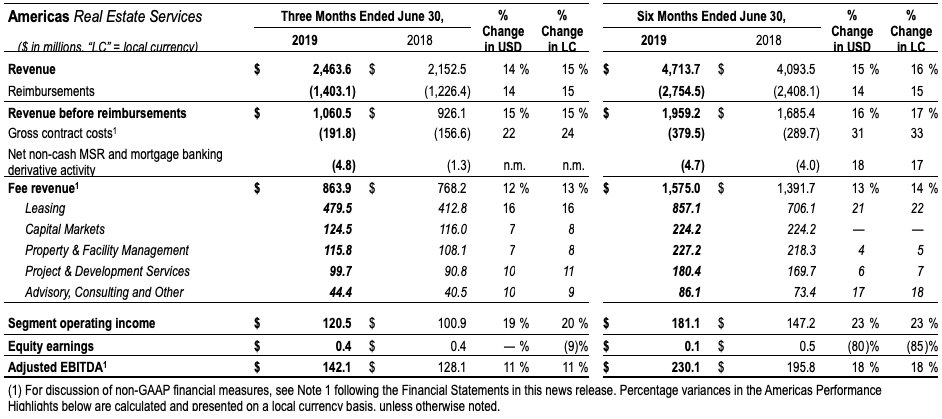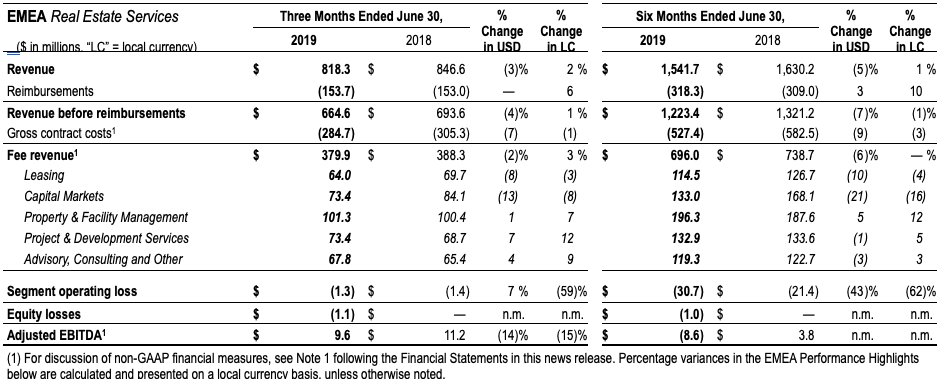CHICAGO — August 21, 2019 — Jones Lang LaSalle Incorporated (NYSE: JLL) today reported operating performance for the second quarter of 2019 with diluted earnings per share of $2.40 and adjusted diluted EPS1 of $2.94.
- Record Real Estate Services revenue and fee revenue up 9% (11% local currency) and 7% (10% local currency), respectively
- Americas Leasing exceptional performance continued
- Corporate Solutions growth across all geographies strengthened annuity base
- Capital Markets investment sales outperformed decline in market volumes
- Margin increase reflected LaSalle contribution and continued expansion in Real Estate Services
- Record LaSalle AUM $68.4B drove excellent advisory fee performance
- Transformative HFF acquisition completed on July 1
“Once again we have grown revenue and expanded margins to deliver record results, with notable contribution from LaSalle and continued expansion in our Real Estate Services business,” said Christian Ulbrich, JLL CEO. “Looking forward, we see strong pipelines contributing to another highly successful year for JLL.”
Consolidated Second-Quarter 2019 Performance Highlights:
The company achieved growth of 12% in both consolidated revenue and fee revenue compared with 2018, predominantly organic. Leasing led consolidated fee revenue growth in the RES service lines, with notable contributions from Project & Development Services and Property & Facility Management. Geographically across service lines, RES fee revenue growth for the quarter was led by Americas, contributing 73% on a local currency basis. LaSalle revenue growth reflected higher incentive and record quarterly advisory fees.
Net income attributable to common shareholders was $110.5 million, compared with $107.8 million last year, and adjusted EBITDA was $226.7 million, compared with $193.6 million. Diluted earnings per share were $2.40, an increase from $2.35 in 2018; adjusted diluted earnings per share were $2.94, up from $2.26 last year. Adjusted EBITDA margin, calculated on a fee-revenue basis, was 13.9% in USD for the quarter (13.8% in local currency), compared with 13.0% in the prior-year quarter.
The 90 basis-points net expansion of consolidated Q2 margin reflected 80 basis points of contribution from LaSalle and 55 basis points of contribution from RES margin improvement, which enhanced the ability to fund 45 basis points of continued investments in platform and client-facing technology.
Balance Sheet and Cash Flows:
Total net debt was $937.4 million as of June 30, 2019, representing decreases of $42.7 million and $35.2 million from March 31, 2019, and June 30, 2018, respectively.
Operating cash flow for the second quarter of 2019 improved nearly $80 million compared with the prior-year quarter, reflecting the normalization of EMEA payments, which had been accelerated in the first quarter in advance of a new financial enterprise system implementation. Year-to-date, the increase in cash used by operating activities was primarily due to higher annual incentive compensation paid to employees, primarily in the first quarter, in 2019 compared with 2018, reflecting improved performance comparing the previous annual periods.
Americas Second-Quarter 2019 Performance Highlights:
Americas revenue growth of 15% was strong and broad-based across all service lines, led by Property & Facility Management primarily due to the ramp-up of recent wins and expansion of existing facilities management relationships with U.S. Corporate Solutions clients. Leasing led segment fee revenue growth, driven by the southeast and mid-Atlantic U.S. markets and across all major asset classes. Capital Markets reflected solid growth in both investment sales and debt placement.
Adjusted EBITDA margin, calculated on a fee-revenue basis, was 16.5% in USD for the quarter (16.4% in local currency), compared with 16.7% in 2018. The profitability reflected strong fee revenue growth offset by incremental investments in platform and client-facing technology.
EMEA Second-Quarter 2019 Performance Highlights:
EMEA’s revenue and fee revenue both reflected marginal increases as solid annuity growth in Project & Development Services and Property & Facility Management was partially offset by softness in Capital Markets and Leasing. The change in Capital Markets compared favorably to a 20% decline in regional capital markets volumes, from the prior-year quarter, as reported by JLL Research.
Adjusted EBITDA margin, calculated on a fee-revenue basis, was 2.5% in USD (2.4% in local currency) for the quarter, compared with 2.9% last year. The profitability decrease primarily reflected the shift in business mix toward annuity revenues.
Asia Pacific Second-Quarter 2019 Performance Highlights:
Asia Pacific healthy growth in revenue and fee revenue across all services lines was highlighted by a double-digit increase in Leasing, primarily office and industrial sectors, and notable growth in Property & Facility Management, primarily due to expansion of existing client mandates and new client wins for Corporate Solutions.
Adjusted EBITDA margin, calculated on a fee-revenue basis, was 12.8% in USD for the quarter (12.9% in local currency), compared with 12.0% in 2018. The 21% increase in segment operating income and 90 basis point margin expansion reflected the growth in transactional revenue together with continued cost discipline, which more than offset incremental investments in platform and client-facing technology.
LaSalle Second-Quarter 2019 Performance Highlights:
LaSalle’s substantial revenue increase was driven by higher incentive fees, associated with real estate dispositions in Asia Pacific on behalf of clients, and notable growth in advisory fees, achieving a record level. More than half of the advisory fees growth was from strong private equity capital raising with the balance attributable to recently acquired assets under management.
Equity earnings were primarily driven by net valuation increases in Asia Pacific, while the prior year was driven by net valuation increases in Europe and Asia Pacific.
Adjusted EBITDA margin was 33.7% in USD and local currency for the quarter, compared with 28.5% last year. The increase in profitability reflected higher incentive fees and equity earnings.






